Tables and diagrams of the results of their testing will tell you more clearly about the performance of processors. But first, let's take a look at the testers.
From the Core i family, models from different series were deliberately chosen, but with the same clock speed and the number of cores and threads (Core i3-550 and Core i5-650). The older Core i7 models even have a slightly lower operating frequency, which, however, will not prevent them from overtaking everyone and everything.
Two dual-core processors were chosen as opponents: Core 2 Duo E8500 from Intel and Athlon 64 X2 6400+ from AMD. And with quad-core Intel Core i7 competed AMD Phenom II X4 965. Their characteristics can be seen in Table 1.
Factors affecting performance in solving typical tasks
There are a lot of tasks that the user puts before the computer today. Even if you test processors in all areas of activity, anyway, some program poorly optimized for multi-core will spoil the whole impression.
For example, programs for visualizing 3D scenes cannot boast of good parallelism, completely managing with a couple of cores. So the clock speed of each core, the speed of the processor with memory, the capacity of the cache memory and other architectural features are of decisive importance, but Hyper-Threading most often does harm.
Table 1. Test participants
| CPU | Core | Cores/ Thread V | Frequency, MHz | Tire | L1 cache, KB | L2 cache, KB | L3 cache, KB | Connector | Process | TDP, W | Price, USD |
| AMD Athlon 64 X2 6400+ | windsor | 2/2 | 3200 | NT | 128×2 | 2048 | AM2 | 90 nm | 125 | 45-51 | |
| AMD Phenom II X4 965 | Deneb | 4/4 | 3400 | NT | 128×4 | 2048 | 6144 | AMZ | 45 nm | 140 | 160-225 |
| Intel Core 2 Duo E8500 | wolfdale | 2/2 | 3166 | FSB | 64×2 | 6144 | LGA775 | 45 nm | 65 | 197-217 | |
| Intel Core i3-550 | Clarkdale | 2/4 | 3200 | DMI | 64×2 | 512 | 4096 | LGA1156 | 32 nm | 73 | 117-145 |
| Intel Core i5-650 | Clarkdale | 2/4 | 3200 | DMI | 64×2 | 512 | 4096 | LGA1156 | 32 nm | 73 | 170-226 |
| Intel Core i7-860 | Lynnfield | 4/8 | 2800 | DMI | 64×4 | 1024 | 8192 | LGA1156 | 45 nm | 95 | 269-321 |
| Intel Core i7-950 | Bloomfield | 4/8 | 3067 | QPI | 64×4 | 1024 | 8192 | LGA1366 | 45 nm | 130 | 296-332 |
Table 2. Compression in WinRar 3.8
| CPU | Compression, Kb/s |
| AMD Athlon 64 X2 6400+ | 1028 |
| AMD Phenom II X4 965 | 2210 |
| Intel Core 2 Duo E8500 | 1203 |
| Intel Core i3-550 | 1745 |
| Intel Core i5-650 | 1766 |
| Intel Core i7-860 | 3041 |
| Intel Core i7-950 | 3248 |
Table 3. Video encoding
| CPU | DivX 6.5, sec | WMV9, sec | x264 HD Bench, FPS |
| AMD Athlon 64X2 6400+ | 86 | 126 | 28 |
| AMD Phenom II X4 965 | 50 | 96 | 77 |
| Intel Core 2 Duo E8500 | 57 | 97 | 40 |
| Intel Core i3-550 | 59 | 113 | 53 |
| Intel Core i5-650 | 59 | 112 | 53 |
| Intel Core i7-860 | 40 | 99 | 71 |
| Intel Core i7-950 | 37 | 81 | 81 |
The same applies to programs for scientific and engineering calculations. For example, engineering CADs, apparently, operate with fairly large amounts of information when calculating, but the second core is often ignored.
Sadly, but programs for processing 20-graphics that have already become everyday, such as Adobe Photoshop, ACDSee, Corel PaintShop and others are also poorly optimized and use only a couple of cores out of all possible.
Therefore, for the greatest efficiency, you should choose applications written for the .NET platform, which itself is well optimized.
Data compression
As practice shows, modern archivers do not need more than two cores, but to various characteristics memory subsystems, they are very susceptible to everything, including the L3 cache.
So, for example, the 7-Zip archiver can use the third core. The Win-RAR archiver, apparently, operates so far with only two cores, and when unpacking, in general, only one.
See the test results in table 2 and in fig. 2 (the higher the value, the better).
Video conversion
It should be noted that the logic of the work of modern and even not very modern video codecs "falls" on the Nehalem architecture just perfectly.
The usefulness of Hyper-Threading is generally extremely difficult to dispute. And if we compare Phenom II X4 965 and Core i7-950, then even Phenom has a head start in the form of a significantly higher clock frequency does not save the situation.
In short, the more threads a processor can handle at the same time, and the more cache, the better. See the results in table 3 and in fig. 3 (the lower the value in seconds, the better).
Gaming 3D
New games have already learned to load all available cores, and only old games load 2-3 cores. Therefore, the more virtual cores a processor has, the better.
See the result in table 4 and in Fig. 4 (the higher the value, the better).
Tab. 4. Gaming performance
| CPU | Far Cry 2, 1280×1024, FPS | World in Conflict, 1024×768, FPS |
| AMD Athlon 64 X2 6400+ | 53 | 32 |
| AMD Phenom II X4 965 | 100 | 56 |
| Intel Core 2 Duo E8500 | 74 | 45 |
| Intel Core i3-550 | 85 | 52 |
| Intel Core i5-650 | 85 | 52 |
| Intel Core i7-860 | 125 | 60 |
| Intel Core 17-950 | 137 | 69 |
Results
Two perhaps the most powerful desktop x86 processors in the world with 6 cores, L2 256 × 6 KB and L3 12 MB did not participate in the test: Core i7-980X Extreme Edition (3.33 GHz, $1083-1141) and Core i7- 990X Extreme Edition (3.46 GHz, $1110-1168).
Thanks to Hyper-Threading Technology operating system reports about the presence of 12 cores! And due to Turbo Boost, the frequency of these processors can be increased to at least 3.6 GHz and 3.72 GHz, respectively.
Contemplating such a "monster" you experience a double feeling. On the one hand, this gigantic (for desktop) power is fascinating as always. On the other hand, there are well-founded doubts that it is absolutely necessary for a top desktop processor to be 6-core.
Moreover, Intel itself positions its Extreme-series as processors for gamers-enthusiasts. Well, where are the gamers with their only 2-3 threaded games and where are the available 6 cores?!
Well let's not talk about sad things. It is not at all necessary for everyone to keep an elephant in their own apartment, but to admire this strong and majestic animal in the zoo - why not?
Another sad aspect is that, along with the increase in processor cores, software developers do not have time to optimize it, and as a result, for one additional core in the system, the performance increase is only 45%, and not 100%, as it should ideally be.
It turns out that often, when buying a 2-core, we get performance at the level of 150% of a single-core instead of 200%. And buying a 3-core - 200% only, instead of 300%. Alas, this also applies to AMD processors.
And it's pointless to be offended by this, you just need to remember this when choosing, for example, between two cores and four, and even more so between four or more.
Motherboards
I'll tell you about a few, so to speak, "native" motherboards for Core processors i from Intel. It's not because they're the best: it's almost impossible to even briefly review motherboards from all manufacturers, such as Gigabyte, ASUS, MSI, Biostar, AsRock, EliteGroup, etc. on the pages of our magazine.
For Core i7-9xx (LGA1366 socket)
Both motherboards support 3-channel memory mode. Supported DDR3 memory type. Maximum Supported throughput memory and its standards, see the description of the processor.
Model: Intel DX58S02<Х58>ATX
Support
Slots: 6xDDR3, PCI, 2xPCI-E1x, 3xPCI-E 2.0 16x
Ports: 2xUSB 3.0, 6xUSB 2.0, IEEE1394 (6-pin), 2xESATA, 2xRJ-45 LAN, S/PDIF-out, Une-in, Mic-ln, Front-out, rear-out, sub/center-out
Price: $280-290
Model:INTEL DX580G ATX
Support: Core i7-9xx, Core i7-965 Extreme Edition (Bloomfield).
Slots: 6xDDR3, PCI, 3xPCI-E 1x, 2xPCI-E 2.0 16x
Ports: 2xUSB 3.0, 6xUSB 2.0, IEEE1394 (6-pin), RJ-45 LAN, S/PDIF-out, Line-out, Line-in, Mic-in
Price: $222-231
FOR Core i3, i5, i7-8xx (LGA1156 socket)
ATTENTION!: despite the fact that the motherboard has a port for connecting a monitor, the video core built into the processor is used to form an image. Therefore, when using processors without built-in video, the video outputs on the board do not work.
To activate the 2-channel memory mode, the modules are installed in pairs.
Model: INTEL DH55PJ<Н55>Dsub+DVI MicroATX (р.8)
Support
Slots: 2xDDR3, PCI, 2xPCI-E 1x, PCI-E 2.0 16x
Ports: PS/2, 6xUSB 2.0, RJ-45 LAN, VGA, DVI-D, Line-out, Line-in, Mic-in
Price: $93-104
Model: INTEL DQ57TML Dsub+DVI MicroATX
Support: Core i7-8xx, Core i5-6xx/7xx, Core i3-5xx, Pentium G6xx0 (Lynnfield, Clarkdale)
Slots
Ports: PS/2, 4xUSB 2.0, LPT, RJ-45 IAN, VGA, DVI-D, Line-out, Line-in, Mic-in
Price: $126-134
Model: INTEL DP55WG ATX
Support: Core i7-8xx, Core i5-6xx/7xx, Core i3-5xx, Pentium G6xx0 (Lynnfield, Clarkdale).
Slots: 4xDDR3, PCI, 2xPCI-E 1x, 3xPCI-E 2.0 16x
Ports: 8xUSB 2.0, IEEE1394 (6-pin), RJ-45 LAN, S/PDIF-out, S/PDIF-in, Line-in, Mic-in, Front-out, rear-out, sub/center-out, Surround out
Price:$155
Model: INTEL DH55HC DVI HDMI ATX (Figure 10)
Support: Core i7-8xx, Core i5-6xx/7xx, Core i3-5xx, Pentium G6xx0 (Lynnfield, Clarkdale)
Slots: 4xDDR3, PCI, 2xPCI-E 1x, PCI-E 2.0 16x
Ports: PS/2, 6xUSB 2.0, RJ-45 LAN, VGA, DVI-D, HDMI, Line-out, Line-in, Mic-in Price: $99-113
Valentin Matveev. According to the magazine "Computer"
3 GHz? 4 GHz? No problem! Nearly all Core i5 and Core i7 processors are capable of running at overclocked speeds for impressive performance. All you need is the right platform to meet your overclocking ambitions. However, a product as efficient as the Core i5/i7 processor will no longer be as efficient in terms of power consumption if its clock speeds are overclocked to extreme levels. We decided to test the Core i5-750 and overclocked it (with active Turbo Boost technology at the request of our readers) to find the clock speed that could provide the most optimal performance per watt.
How much does it make sense to overclock the CPU?
Efficiency and power consumption have become important criteria when evaluating the latest CPUs, in addition to performance, additional features and prices that have been discussed for many years. The conservation of natural resources around the world today is hot topic, of course, and we do not recommend wasting more energy than necessary. But as for computer hardware, one should not be overly zealous in the matter of ecology - you still won’t save the world. It is necessary to assemble a balanced and reasonable system, focusing on common sense.
A few years ago, when overclocking would not be as popular and widespread as it is today, enthusiasts mainly wanted to get maximum performance. It was a perfectly logical step. More fast systems(and processors in particular) were highly desirable, even if current computers entry level have sufficient performance for almost all mainstream PC applications (with the exception of games). However, in the past, the energy expended was not treated as scrupulously as it is today. The main limitation with decent overclocking was not power consumption, but heat dissipation.
In the first half of the past decade, AMD and Intel increased the power consumption of their processors, pushing the Pentium III's 30W days TDP to over 130W. Some processors, such as the fastest Pentium 4 models, even turned on throttling when they reached their thermal limits. It was then that we began to doubt that a 20% increase in clock speed with almost doubling power consumption hardly makes sense.
In search of the "golden mean"
We have repeatedly searched for the best balance between overclocking, performance and power consumption to find the most efficient operating parameters for the Core 2 Duo, Core i7 and Phenom II X4. For getting additional information On this topic, we recommend that you read the following articles.
- " Intel Core 2 Duo: overclocking, performance and efficiency analysis ";
- " Intel Core i7: overclocking, performance and efficiency analysis ";
- " AMD Phenom II: Overclocking, Performance and Efficiency Analysis ".
Now it's time to do the same research with the entry-level Intel Lynnfield processor, the Core i5-750, which we consider one of the best and smartest choices for the average user who appreciates high performance.
Core i5-750: the best choice?
Click on the picture to enlarge.
We have already considered the Core i5 / i7 processors for the LGA 1156 platform in some detail, offering our readers the following articles.
- " Exploring Lynnfield: The impact of an integrated PCI Express controller on gaming performance ";
- " Impact of Turbo Boost on the Power Efficiency of Intel Core i5/i7 Processors ";
The entry-level model in the Lynnfield Intel Core i5-750 line at 2.66 GHz has already participated in our article on overclocking, where it proved to be quite good, so we took this processor for efficiency analysis. The processor retails internationally for $196 ($196) and yet delivers better efficiency and higher peak performance than the Core 2 Quad despite a relatively low base clock speed of 2.66GHz. Thanks to the second generation of Intel Turbo Boost, the processor accelerates its clock speed by up to four steps (each step by 133 MHz) when using one or two cores. As a result, the processor runs at up to 3.2 GHz. If three or four cores remain active, then the clock speed will increase from 2.66 to 2.80 GHz.
If we were to take the Core i7-870 processor, the top LGA 1156 model for today, then the maximum clock speed would be 3.6 GHz. It is quite clear that the gain from overclocking in this case would be a little less, and the processor itself would cost more significantly - $562.
Click on the picture to enlarge.
Overclocking Settings and Clock Table
The table below lists all the clock speeds and settings we used for this article. Please note that we had to turn off Turbo Boost when we exceeded 3.2 GHz, as the maximum clock speed would otherwise exceed the maximum stable frequency of about 4.2 GHz. Below is an overview of the clock speeds obtained when increasing the base frequency without modifying the base multiplier (the first column is a 20x multiplier), but with Turbo Boost technologies active (columns with a multiplier of 21x and 24x).
| Overclocking Core i5 (base frequency) | Clock speed with stock multiplier 20x | Max. Turbo Boost frequency with 3 or 4 active cores (multiplier+1) | Max. Turbo Boost frequency with 1 or 2 active cores (multiplier+4) |
| 133MHz BCLK | 2666 MHz (20x multiplier) | 2800 MHz (21x multiplier) | 3200 MHz (24x multiplier) |
| 150MHz BCLK | 3000 MHz (20x multiplier) | 3150 MHz (21x multiplier) | 3600 MHz (24x multiplier) |
| 160MHz BCLK | 3200 MHz (20x multiplier) | 3360 MHz (21x multiplier) | 3840 MHz (24x multiplier) |
| 170MHz BCLK | 3400 MHz (20x multiplier) | 3570 MHz (21x multiplier)* | 4080 MHz (24x multiplier)* |
| 180MHz BCLK | 3600 MHz (20x multiplier) | 3780 MHz (21x multiplier)* | 4320 MHz (24x multiplier)* |
(*) The settings were unstable without adding core voltage, which we tried to avoid.
Regardless of the possible limits of the processor thermal package, our Core i5-750 did not run faster than 3.7 GHz without raising the voltage. As a result, the base clock speed of 160 MHz was the maximum stable clock speed at which we were able to keep the Turbo Boost technology active without increasing the voltage.
Of course, you can increase the voltage of the processor to raise the clock speeds both in normal mode and after Turbo Boost, but this will lead to a decrease in efficiency in all operating modes. Therefore, the base frequency of 160 MHz BCLK with a nominal speed of 3.2 GHz and a Turbo Boost frequency of 3.36 GHz with three and four cores and 3.8 GHz with one or two cores is the maximum in our case.
| Clock table | |||
| Core i5-750 | 3000 MHz | 3200 MHz | 3400 MHz |
| base frequency | 150 MHz | 160 MHz | 170 MHz |
| turbo boost | Yes | Yes | No |
| 71 W | 71 W | 72 W | |
| 160 W | 164 W | 168 W | |
| BIOS Vcore | 1.213 V | 1.213 V | 1.213 V |
| CPU-Z VT idle | 1.224 V | 1.224 V | 1.224 V |
| CPU-Z VT load | 1.176 V | 1.176 V | 1.176 V |
| CPU VTT | 1.101 V | 1.101 V | 1.101 V |
| PCH | 1.81 V | 1.81 V | 1.81 V |
| RAM | 1.51 V | 1.51 V | 1.51 V |
| Fritz Chess Test | 9167 | 9642 | 9981 |
| Stable work | Yes | Yes | Yes |
| Clock table | ||||
| Core i5-750 | 3600 MHz | 3800 MHz | 4000 MHz | 4200 MHz |
| Base clock | 180 MHz | 190 MHz | 200 MHz | 210 MHz |
| turbo boost | No | No | No | C-states off |
| Idle system power consumption | 73 W | 75 W | 79 W | 122 W |
| Peak system power consumption | 175 W | 195 W | 245 W | 265 W |
| BIOS Vcore | 1.251 V | 1.32V | 1.45V | 1.52V |
| CPU-Z VT idle | 1.256 V | 1.328 V | 1.448 V | 1.512 V |
| CPU-Z VT load | 1.208 V | 1.272 V | 1.384 V | 1.44V |
| CPU VTT | 1.101 V | 1.149 V | 1.25V | 1.303 V |
| PCH | 1.81 V | 1.85V | 1.9V | 1.9V |
| Memory | 1.51 V | 1.51 V | 1.51 V | 1.51 V |
| Fritz Chess Test | 10405 | 11008 | 11501 | 12157 |
| Stable work | Yes | Yes | Yes | Yes |
At the beginning of 2017 Intel launched seventh-generation desktop processors under the name Kaby Lake. The processor came to our editorial office Intel Core i5-7600K with an unlocked multiplier. In the seventh generation models, overclocking capabilities have been improved, integrated graphics have been updated, and new technologies have been added.
Let's not waste time on theoretical discussions about the tick-tock strategy and details about the 14-nm process technology. Many publications talked about this even before the processors went on sale.
We will provide you with practical information on testing the capabilities of the Core i5-7600K processor on a motherboard with a Z270 chipset. Let's overclock the processor and test the graphics capabilities.
SPECIFICATIONS
- Model: Intel Core i5-7600K;
- Codename: Kaby Lake
- Processor socket: Socket LGA1151;
- Number of cores/threads: 4/4;
- Base/Dynamic Clock: 3800/4200 MHz
- Multiplier: 38, unlocked;
- Base system bus frequency: 100 MHz
- L1 cache size: 4 x 32 (data memory), 4 x 32 (instruction memory) KB;
- L2 cache size: 4 × 256 KB;
- L3 cache size: 6 MB;
- Maximum TDP: 91W;
- Maximum operating temperature: 100 °C;
- Manufacturing process: 14 nm;
- Instruction and technology support: Intel VT-x, Intel VT-d, Intel Device Protection with Boot Guard, MMX, SSE, SSE2, SSE3, SSSE3, SSE4.1, SSE4.2, EM64T, AEX, AVX, AVX2, FMA3, TSX;
- Memory type: DDR4 / DDR3L;
- Supported frequency: 2400 / 1600 MHz;
- Integrated graphics: Intel HD Graphics 630
- Dynamic frequency: 1150 MHz;
- Average price: 17,000 rubles.
APPEARANCE
The processor came to our office without branded packaging. Judging by the official data, this will be a standard designed box with a window on reverse side. Processors with index "K" are shipped without a cooling system.
The appearance of the processor itself has not changed much. Minor changes have affected the shape of the heat-distributing cover.
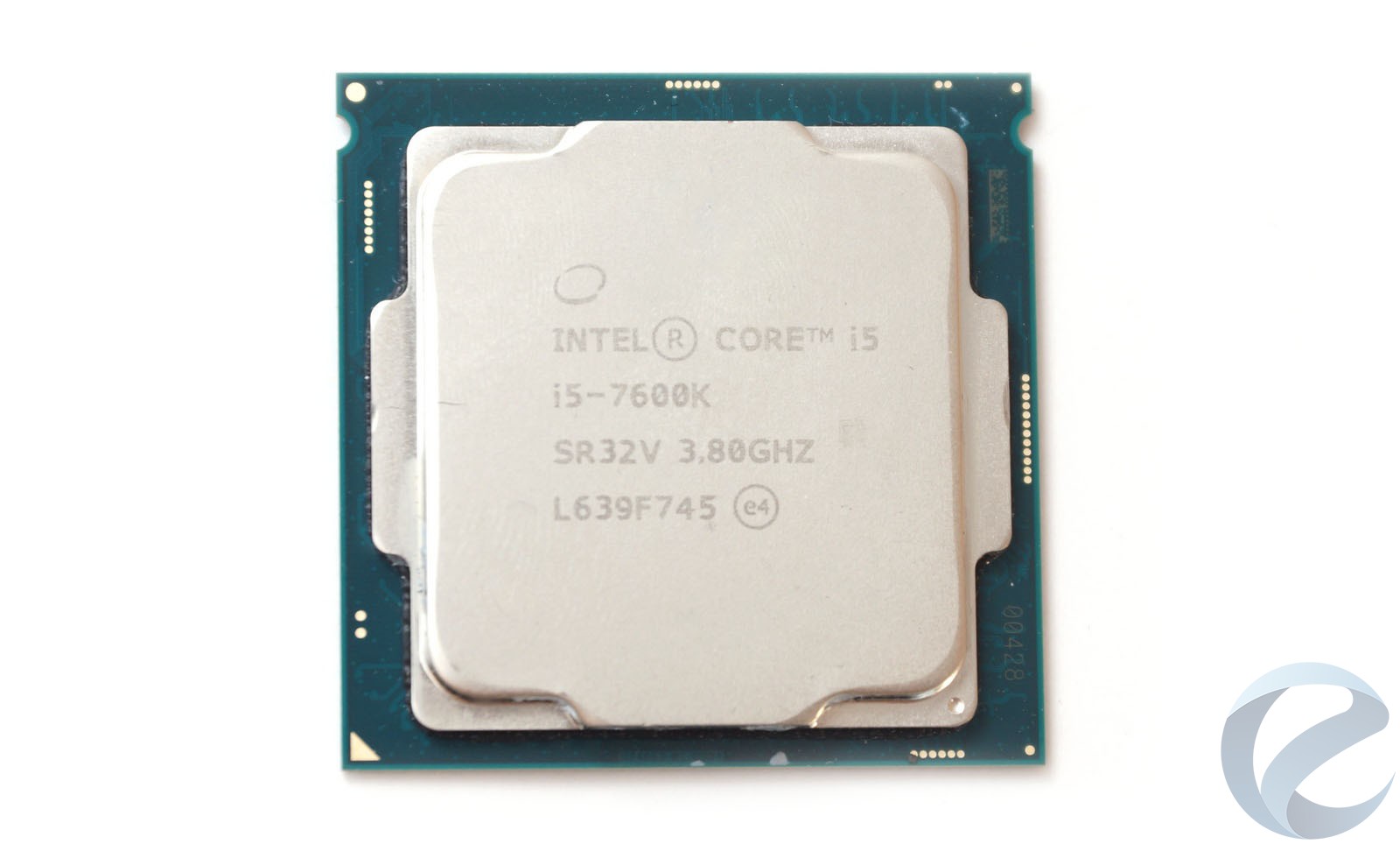
The tabs should make it easier to fit the processor into the socket. But the socket has not changed and the socket frame also presses the processor at two points.
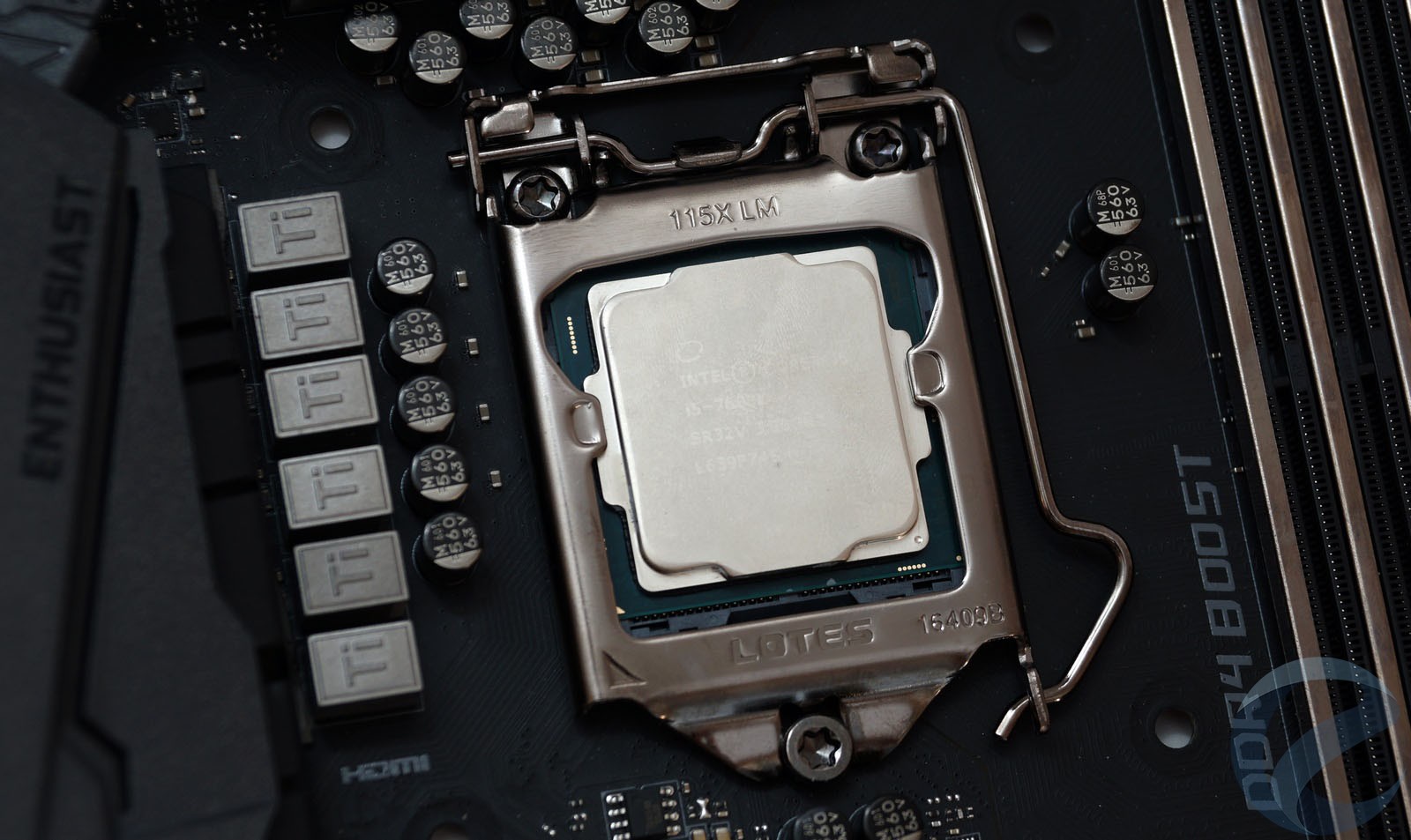
Compared to previous generations, it is difficult to notice changes on the contact pad, just a few contacts.
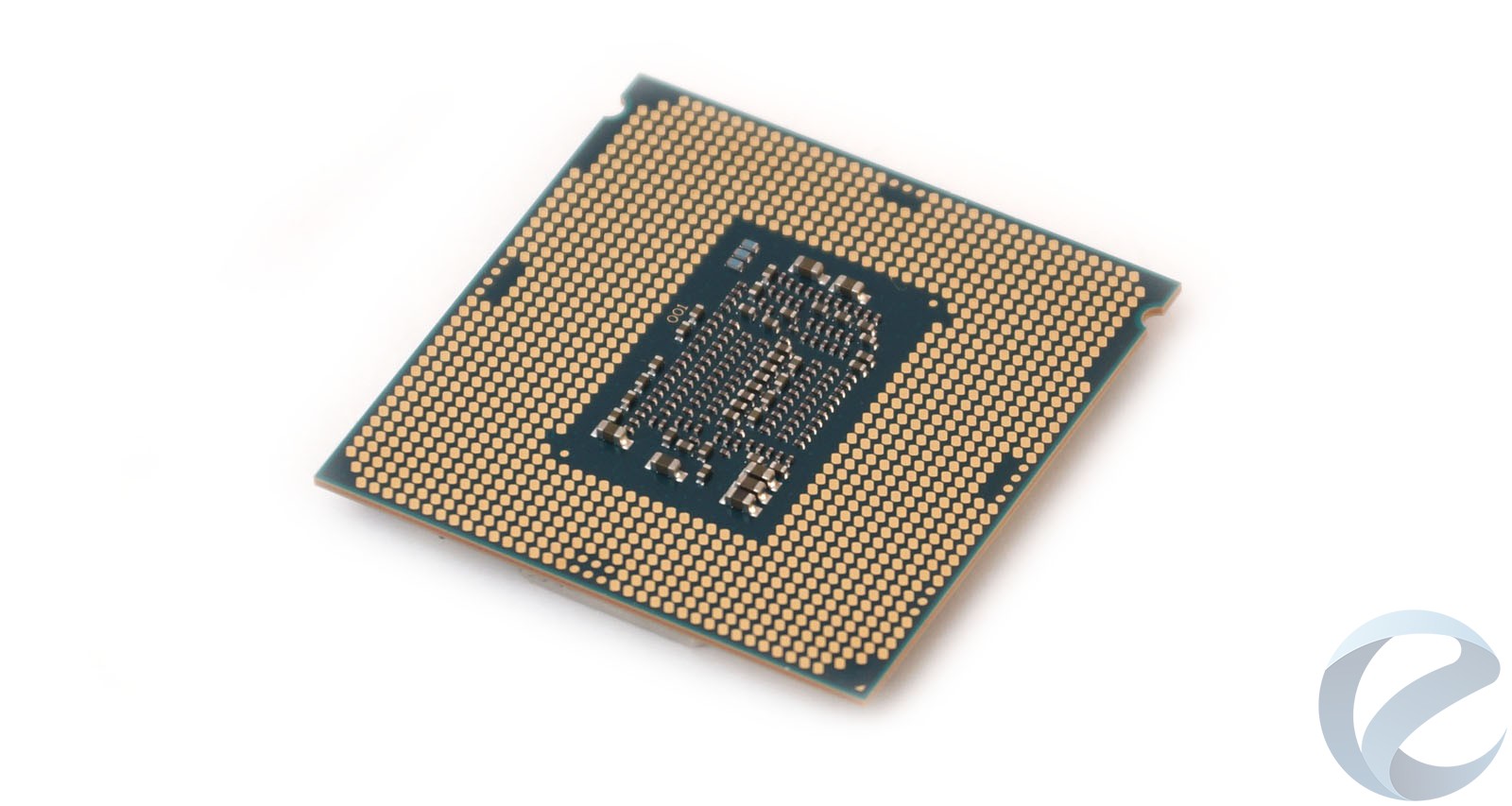
Textolite of the same thickness as its predecessor.
PERFORMANCE ANALYSIS
The nominal frequency of the processor is 3.8 GHz, with the Intel Turbo Boost 2.0 technology activated, the processor most of the time under load operates at a frequency of 4.2 GHz at a voltage of 1.224 V. During the tests, the frequency never dropped to the nominal values - this, apparently, is possible only with insufficient cooling or budget motherboards. When the Game Boost function is enabled on the MSI Z270 GAMING M5 motherboard, the frequency increases to 4.5 GHz, but under load it regularly drops to 3.7 GHz with a corresponding decrease in voltage. During idle, the frequency drops to 0.8 GHz, and the voltage to 0.8 V. During the tests, the following picture was also observed: without load, the voltage was dropped, and the frequency remained at 4.2 GHz. Whether this is due to the characteristics of the BIOS or the processor is not clear.

![]()
Controller random access memory guaranteed to support DDR4 memory modules with a frequency of 2400 MHz. The processor also supports memory of the previous generation DDR3L-1600 MHz.
The dynamic frequency of the integrated graphics adapter Intel HD Graphics 630 1150 MHz. Base frequency 350 MHz. 24 execution units. HDMI and DP image output is supported at a resolution of 4096 × 2304 at 60Hz. It's also possible hardware encoding and playback of HEVC (Main 10) and VP9 codecs developed for YouTube's 4K format. Previous generations of Intel integrated graphics weren't up to the task.
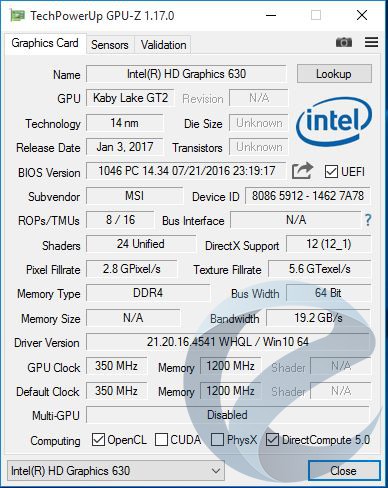
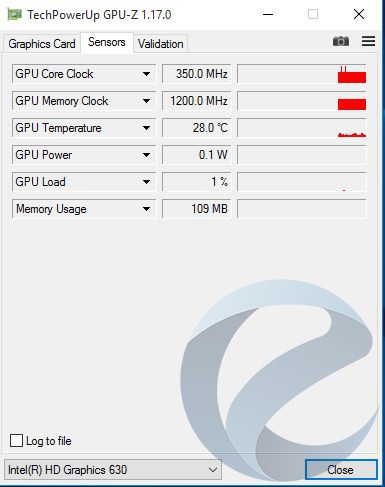
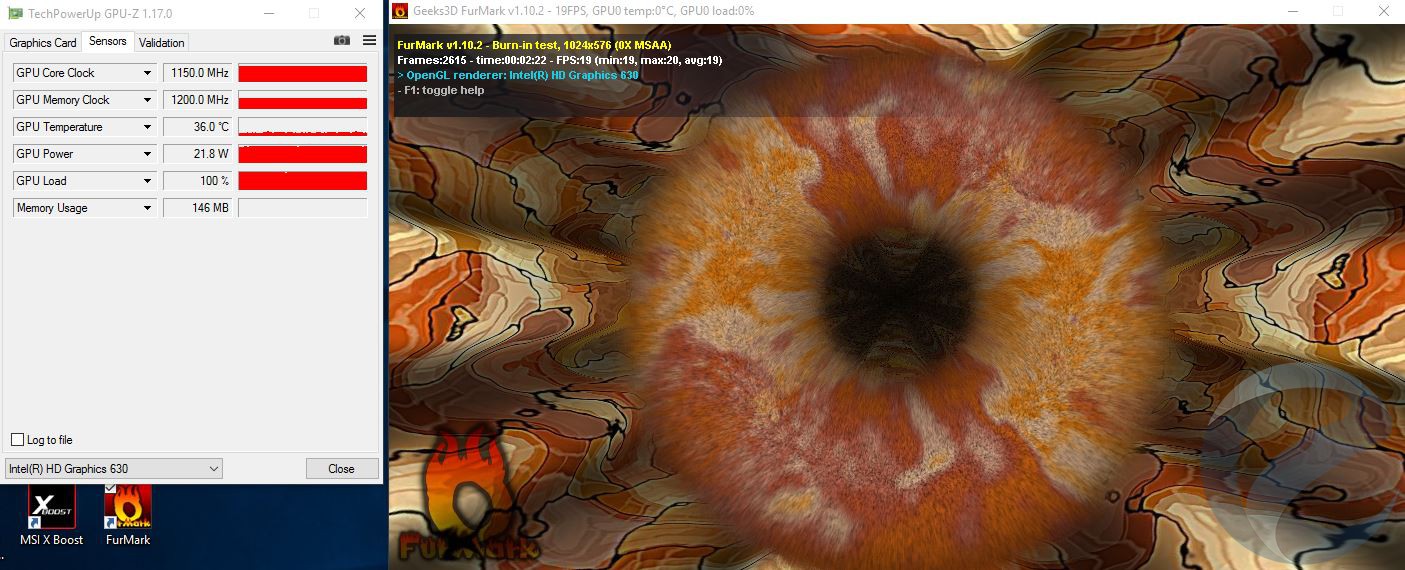
OVERCLOCKING AND TESTING
We will evaluate the performance and overclocking potential of the Intel Core i5-7600K processor on a platform based on the new Z270 chipset.
Test configuration:
- Motherboard: MSI Z270 GAMING M5;
- Thermal interface: ARCTIC MX-4;
- RAM: Qumo DDR-4 2400 8 GB;
- Video card: PowerColor PCS+ R9 370;
- Power supply: Gigabyte G750H Gold;
- Storage: SSD OCZ Solid-3 60 GB;
- Chassis: Thermaltake Core P3 Snow Edition;
- Monitor: Acer S242HL;
- Operating system: Windows 10 64-bit.
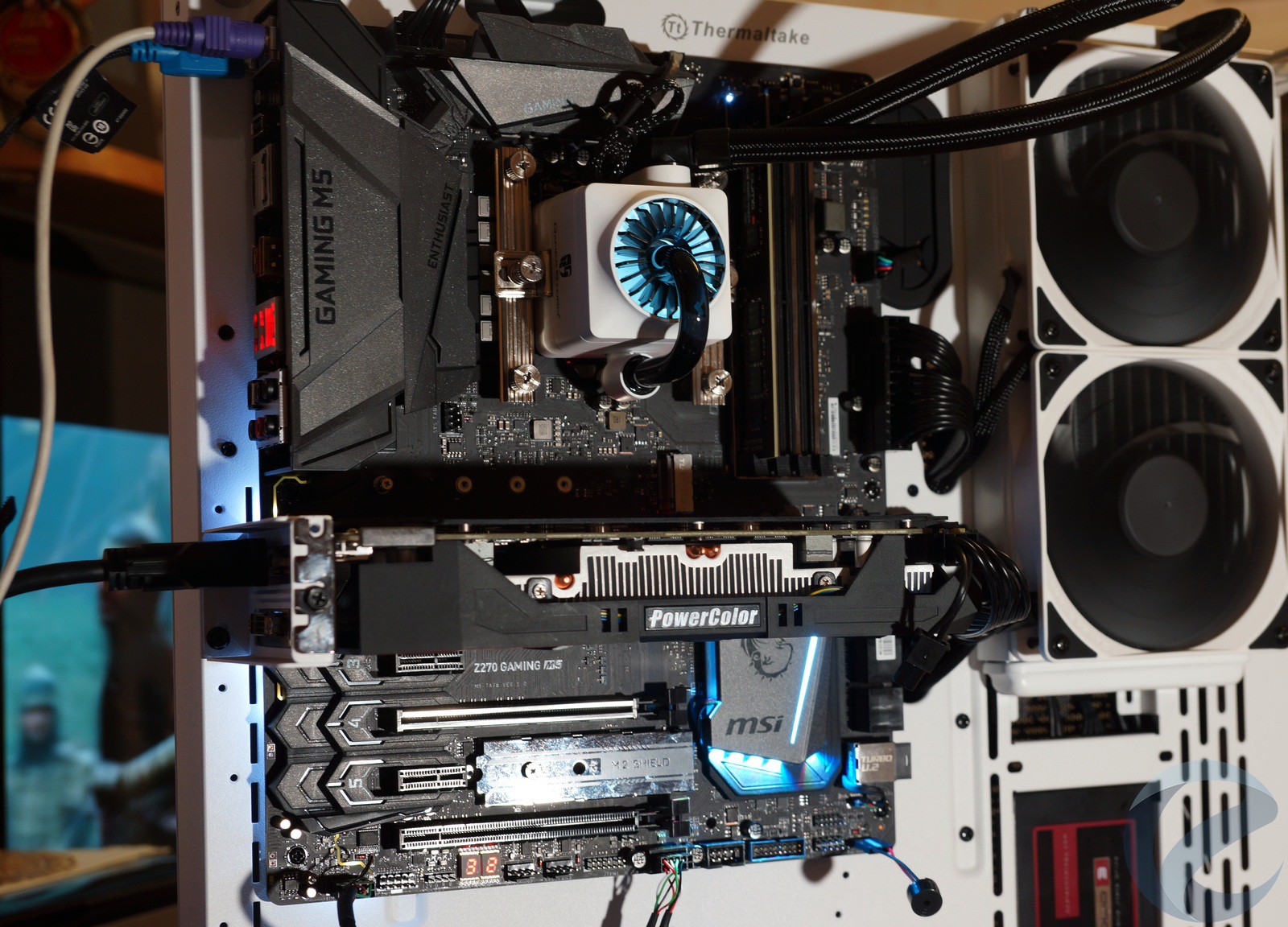
Kaby Lake processors do not have an integrated voltage regulator, as a result, overclocking largely depends on the potential of the motherboard.
You can see the overclocking capabilities of the motherboard in our MSI Z270 GAMING M5 review.
The RAM ran at 2400 MHz with timings of 16-16-16-39 CR2. All Turbo Boost and power saving functions worked as normal. The cooling fans were running at maximum speed.
Activating the "GAME BOOST" function allows you to automatically overclock the i5 7600K processor to 4.5 GHz. The voltage rises to 1.336 V.

In the process of manual overclocking by increasing the multiplier, we managed to achieve stable operation of the processor at a frequency of 4.8 GHz with a voltage of 1.328 V. First, we increased the frequency to stable values, then reduced the Vcore voltage to the minimum possible parameters. The stability of the work was checked by the LinX test for at least 10 minutes. The temperature at the hottest core reached 91 °C.

Processor overclocking can also be done by increasing the base frequency of the CPU. This indicator does not affect other parameters of the system. You can get the same 4.8 GHz by reducing the multiplier to 24 and increasing the base frequency to 200 MHz.

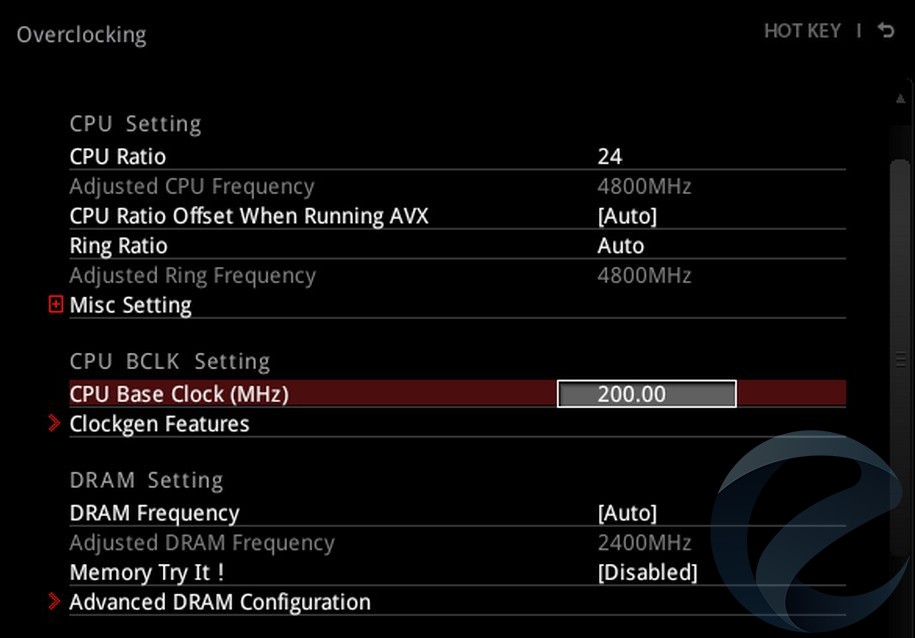
The processor also ran at 5 GHz at 1.35 V, but in the LinX test, the temperature rose to 100 ° C and the computer rebooted. But we managed to get around this situation. helped new feature AVX, which allows you to reduce the multiplier by the selected value when the heat output is exceeded. This value was set to -2. This allowed to reset 200 MHz when executing AVX instructions. The multiplier was set to 45, and the bus frequency was set to 112 MHz, resulting in a processor frequency of 5.04 GHz. The voltage was fixed at a value of 1.344 V. These manipulations made it possible to pass the LinX test for 10 minutes with a maximum temperature of 91 ° C.

The processor was tested in three modes:
- At a nominal frequency of 3.8 GHz with Turbo Boost enabled, which in reality amounted to a frequency of 4.2 GHz.
- At the maximum possible frequency of 4.8 GHz by setting the multiplier to 48.
- And at 5.0 GHz with an AVX value of -2.
We were able to evaluate the change in performance as a result of overclocking in test programs.
CINEBENCH R15
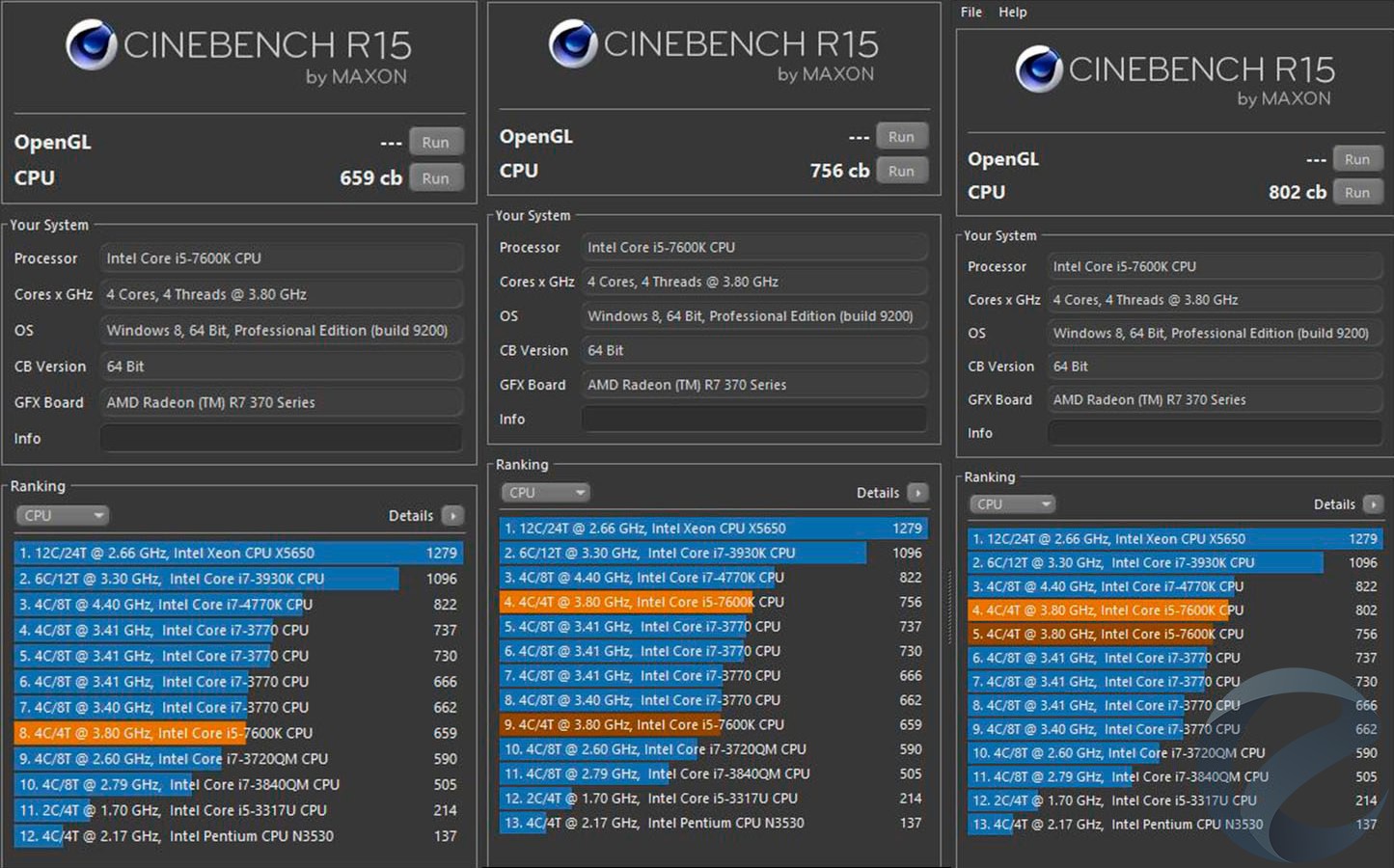

The program demonstrates a good increase in rendering speed by 22%.
WinRAR v5.20

![]()
This program works with archiving, the more the processor gains in the test, the better. The test is run in multi-threaded mode. There are almost no noticeable changes in this program.
PC Mark 8
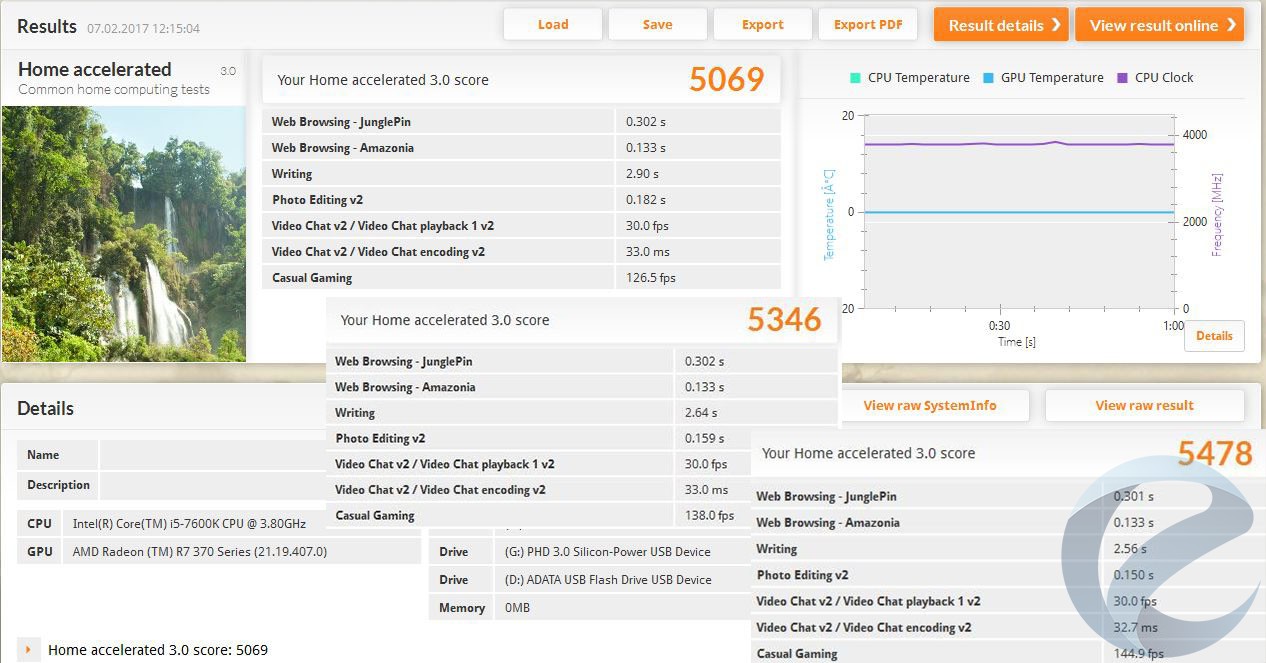
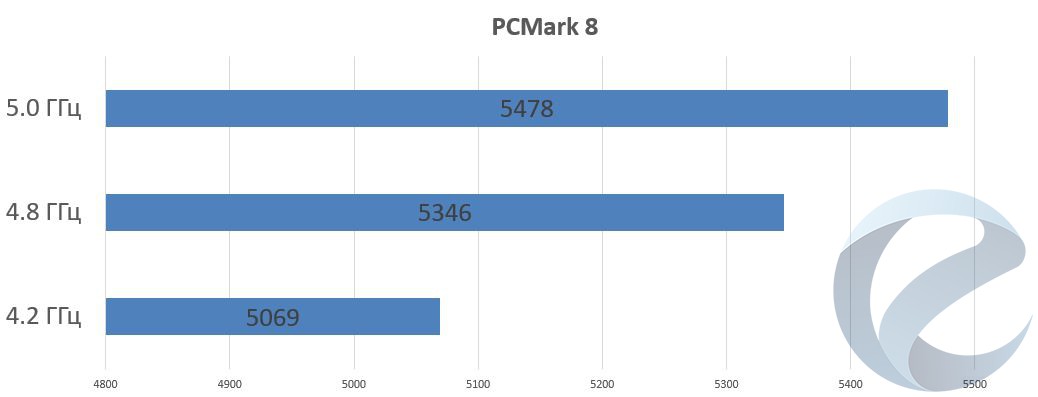
Synthetic PCMark package 8, simulates real everyday tasks. Here we also observe a good increase due to the increased frequency - about 10%.
The test will allow you to evaluate the effect of increased frequency on the speed characteristics of memory.
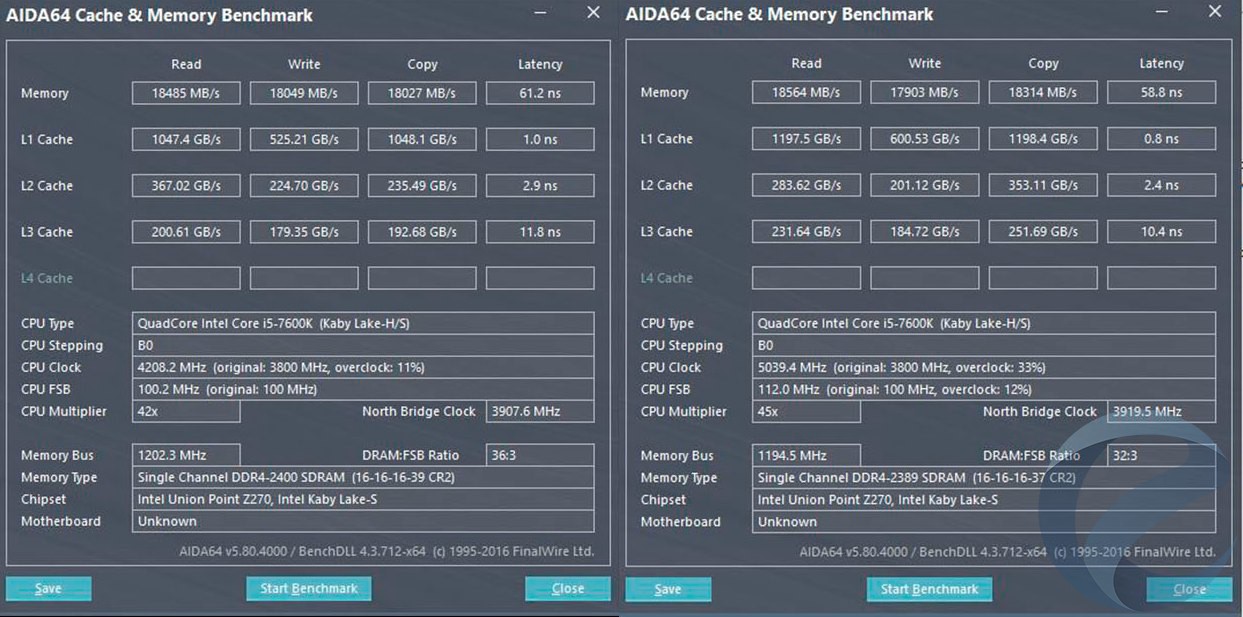
![]()
The increased frequency does not affect the speed characteristics of the memory, the changes are within the margin of error.
HWbot x256 Benchmark v2.0.0
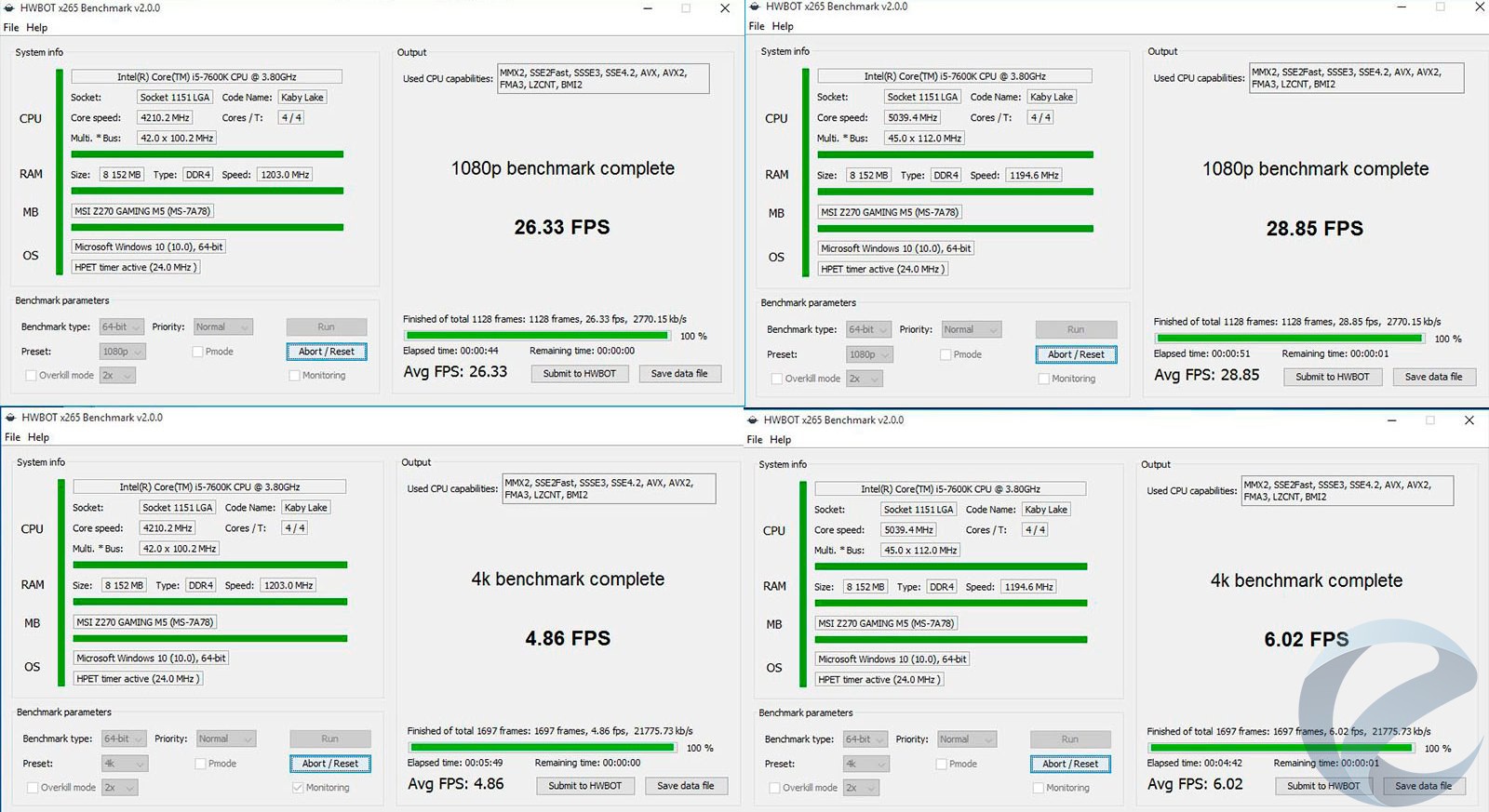
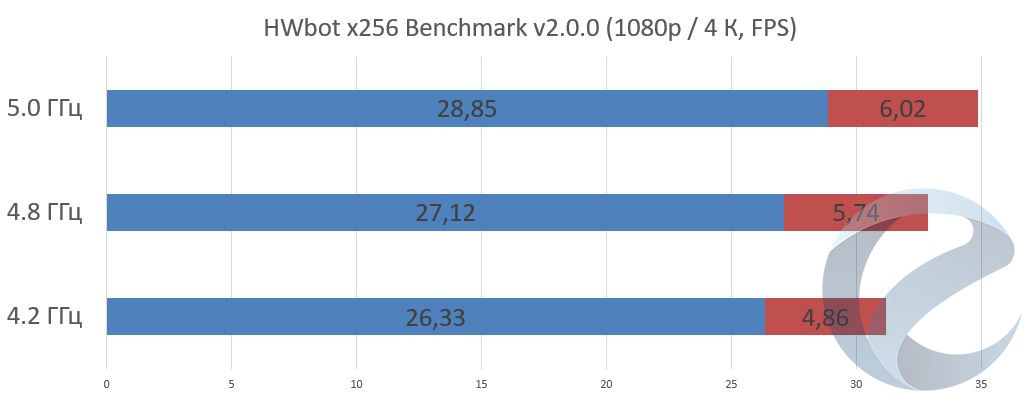
This application will demonstrate the ability to encode high-definition video. The increase is insignificant - a couple of FPS.
wPrime v2.10

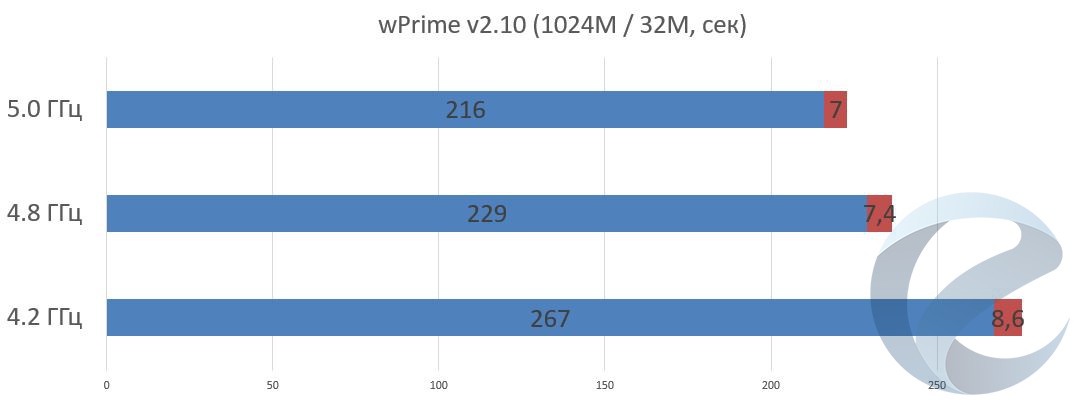
This utility perfectly loads all computational threads with mathematical problems. In this test, the smaller the value, the better the performance. With an increase in the frequency, the calculation speed increases, the increase was 20%.
Fritz Chess Benchmark

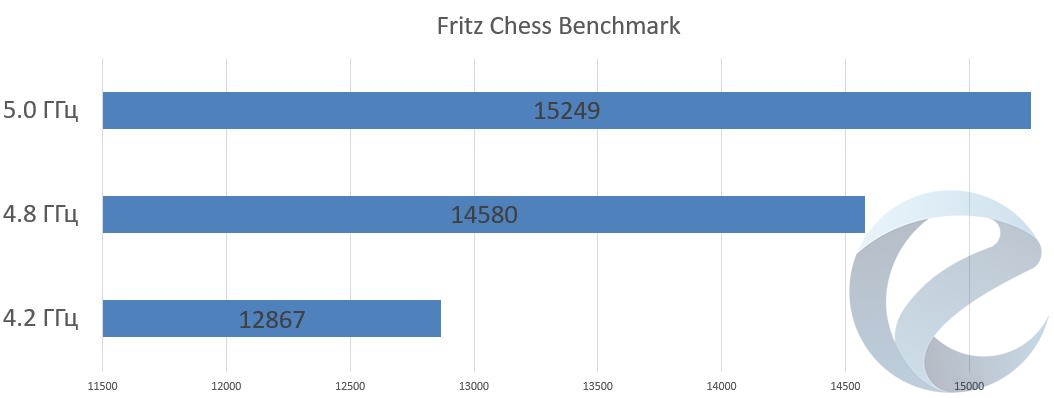
The Fritz Chess Benchmark test calculates algorithms for chess problems. Here, not only multithreading matters, but also the performance of each core. The increase was 17%.
Integrated graphics HD Graphics 630 clearly can not compete with discrete graphics cards. In Full HD resolution, almost all modern games, even at low or medium settings, can hardly overcome comfortable average FPS rates, with drawdowns in minimum FPS. With HD screen resolution and low settings, you can already play at a comfortable FPS level, but the picture quality will not please the eye.
Results in Unigine synthetic tests:
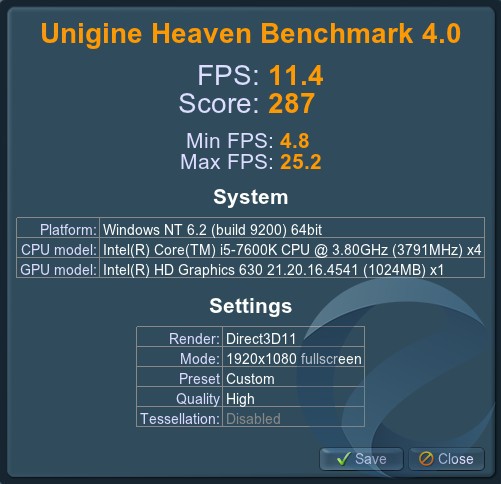

Here is a summary table of average FPS in games on the integrated Intel HD Graphics 630.
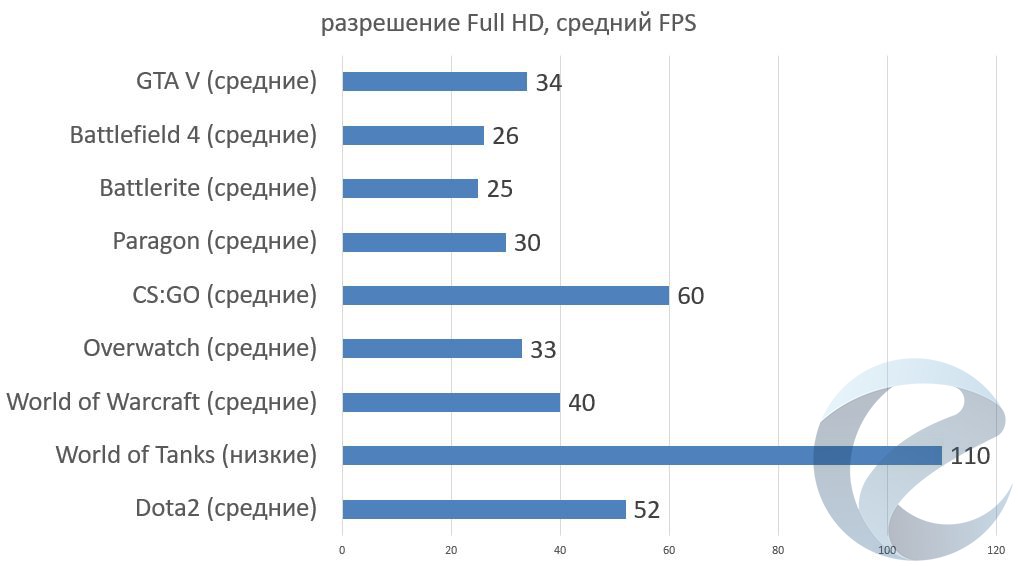
CONCLUSION
The Intel Core i5-7600K processor compares favorably with its predecessors. There have been no revolutionary changes, but new technologies have been added, frequencies and energy efficiency have increased, and integrated graphics have been updated. And most importantly, what is important for buyers of processors with an unlocked multiplier, this processor has good overclocking potential. Simple manipulations, accessible even to a beginner, allow you to overclock it to 5 GHz without significantly increasing the voltage. And a more or less decent cooler can cope with its low heating. Overclockers should appreciate the new product and remember the glory days with successful overclocking of processors. Generations Sandy Bridge.
- Good overclocking potential;
- High performance;
- New technologies: Intel Authenticate, Windows Hello, etc.;
- Support for DDR4-2400 MHz RAM;
- Improving the multimedia capabilities of integrated graphics;
- Support Intel memory Optane memory;
- The shape of the heat-distributing cover has changed;
- Ability to install on motherboards with 100-series chipsets;
- Price at the level of the cost of the predecessor.
- Thin textolite complicating scalping;
- Thermal paste, not solder under the cover.
Intel processors Core i5 for LGA1151 platform
It has become a long tradition to get acquainted with the capabilities of any new platform on the example of top-end K-family processors, and there were no exceptions with LGA1151. The Core i5-6600K and i7-6700K have already been tested in a variety of "poses" by most publications, including us. Actually, Intel's policy to promote new solutions is conducive to just such a development of events: firstly, it is K-modifications of processors that are distributed among reviewers, and secondly, "regular" models are also usually released with some delay relative to the "tops" of families. If you go down below the Core i5 in the "table of ranks", then it sometimes takes several months to collect the entire range of products - for example, Celeron under LGA1151 will have to wait until the new year. And sometimes not all possible modifications of processors appear on the market at all - for example, there are practically no Broadwell desktop models on it. There are no dual-core ones at all, although in the mobile segment it was with them that everything started last fall.
But Skylake is designed for a massive presence in the market, it is not limited to only a part of the segments, like Broadwell (by the way, this is not the first time this has happened - it’s just Ivy Bridge, and Haswell were also massive, so many began to forget the times Sandy Bridge and earlier microarchitectures). For desktop systems, this means that the LGA1150 platform will slowly but steadily be replaced by the LGA1151 platform. This does not mean, of course, that the components of the first platform will instantly disappear from retail chains, however ... Just look at the leftovers of LGA1155, which was the main one only two and a half years ago: system board at least an average level (not to mention a high one) today can only be purchased on the secondary market, and a wide selection of processors is only available there. Accordingly, in order not to find yourself in a similar situation in a couple of years if repair and / or modernization is necessary, it makes sense to purchase a newer solution right now, other things being equal. The only thing that can prevent this is the presence of a large amount of DDR3 memory (if it is necessary to upgrade an old system from LGA1156 or an older platform, this is quite possible), but, as we have already found out, the desire to use DDR3 in a new platform does not lead to radical problems, but suitable boards are on sale. Another question is that over time DDR3 runs the risk of repeating the fate of DDR2, which is on sale, but now costs twice as much as DDR3 / DDR4, so in order not to get into a dead end over time (again - if repair or upgrade is necessary), it is better without the need still do not mess with the "old" memory.
In general, the time is passing when the LGA1151 was just a hot novelty and a subject for theoretical discussions - the usual workdays of the buyer begin. Accordingly, it's time to test the usual mass models of processors: after all, the segment of processors with a CRP above $200 accounts for literally 3% of sales, and it includes both all Core i7 and older Core i5. However, older Core i5s fall into it at the very edge, so they are also interesting - especially the Core i5-6600, from the point of view of a buyer who does not plan to overclock anything, is almost identical to the i5-6600K in terms of main characteristics (which is not at all similar to the situation in the top segment , where the i7-6700 and i7-6700K just don't overlap in clock speeds). We have already tested the most affordable quad-core processor of the new family, but there is also an “intermediate” i5-6500. In general, the time has come to study the entire family (so far without models with a TDP of 35 W), which we will do today.
Test stand configuration
| CPU | Intel Core i5-6400 | Intel Core i5-6500 | Intel Core i5-6600 | Intel Core i5-6600K |
| Kernel name | skylake | skylake | skylake | skylake |
| Production technology | 14 nm | 14 nm | 14 nm | 14 nm |
| Core frequency std/max, GHz | 2,7/3,3 | 3,2/3,6 | 3,3/3,9 | 3,5/3,9 |
| Number of cores/threads | 4/4 | 4/4 | 4/4 | 4/4 |
| L1 cache (total), I/D, KB | 128/128 | 128/128 | 128/128 | 128/128 |
| L2 cache, KB | 4×256 | 4×256 | 4×256 | 4×256 |
| Cache L3 (L4), MiB | 6 | 6 | 6 | 6 |
| RAM | 2×DDR4-2133 | 2×DDR4-2133 | 2×DDR4-2133 | 2×DDR4-2133 |
| TDP, W | 65 | 65 | 65 | 91 |
| Graphic arts | HDG530 | HDG530 | HDG530 | HDG530 |
| EU quantity | 24 | 24 | 24 | 24 |
| Frequency std/max, MHz | 350/950 | 350/1050 | 350/1150 | 350/1150 |
| Price | T-12873939 | T-12873965 | T-12874017 | T-12794521 |
So on this moment Intel offers customers seven Core models i5 under LGA1151, and all of them are quad-core processors, even in the T-family there are no more dual-core processors - for the first time such remained only among notebook processors, and two quad-core Core i5 appeared there for the first time. In principle, this is not surprising - as we can see, the heat pack of "regular" processors has been reduced to 65 W, which was once the standard only for dual-core processors, and even then not all fit. The company began working on such a “revolution” back in the days of Ivy Bridge, but then it didn’t work out very well, and Haswell generally had to “retreat” to its usual positions. Now the process is over: only “overclocker” models live above 65 W.
What else is interesting? Starting frequencies look funny: 6400 and 6500 differ by as much as 500 MHz, and 6500 and 6600 - by only 100. At the same time, the maximum frequency in Turbo Boost mode is a flat line with a step of 300 MHz, which is perhaps more important, since at this frequency some cores at least sometimes work, but never on the starting one (with Turbo Boost enabled, of course). Most likely, in practice, the maximum frequency will be evenly reached or not reached by all, so that the processors will line up in an even line in terms of performance. But that's what we're going to check today.
| CPU | Intel Core i5-3570 | Intel Core i5-4460 | Intel Core i5-4690K |
| Kernel name | Ivy Bridge | Haswell | Haswell |
| Production technology | 22 nm | 22 nm | 22 nm |
| Core frequency std/max, GHz | 3,4/3,8 | 3,2/3,4 | 3,5/3,9 |
| Number of cores/threads | 4/4 | 4/4 | 4/4 |
| L1 cache (total), I/D, KB | 128/128 | 128/128 | 128/128 |
| L2 cache, KB | 4×256 | 4×256 | 4×256 |
| Cache L3 (L4), MiB | 6 | 6 | 6 |
| RAM | 2×DDR3-1600 | 2×DDR3-1600 | 2×DDR3-1600 |
| TDP, W | 77 | 84 | 88 |
| Graphic arts | HDG 2500 | HDG4600 | HDG4600 |
| EU quantity | 6 | 20 | 20 |
| Frequency std/max, MHz | 650/1150 | 350/1200 | 350/1200 |
| Price | T-7959562 | T-10820134 | T-10887398 |
With whom to compare? First, we need a Haswell junior and senior. The youngest (i5-4430) has not been seen on sale for a long time, so there is still no point in testing it, but the 4460 is a very popular model, because it is cheap (and in the year since its appearance, this quality has begun to be valued much more than before ). Well, let's take the older Core i5-4690K, which, by the way, we even compared with the 6600K only when paired with a discrete video card, and now it's time to evaluate them in conditions that are more common in practice. However, specifically for the K-family, maybe not more often, but the 4690K has complete analogue no unlocked multipliers. The analogue is completely complete: with the same frequencies and even TDP of the same level (the difference is only 4 W). From the point of view of the search for the Holy Grail, such as the study of "pure progress", of course, it would be worth testing S-modifications of processors, but from a practical point of view, this is not interesting. It is important for the buyer that you can simply buy (and at the same cost), and the heat pack in a regular modular desktop, at least in the Mini-ITX format, does not matter much. Did Intel consider it possible to make it more rigid by default? So, if this affects performance, the company itself is to blame :)
In principle, when viewed from the side of the buyer, these two processors are enough. Why is Core i5-5675C not required? This is already a well-studied model, strong and weak sides which is well known: a processor with the most powerful integrated graphics in its class, but more expensive than any socket Haswell and Skylake, is obviously a niche solution: it is needed only by those who “hunt” for a powerful GPU. If there is such a need, then the i5-5675C has no alternatives, but if there is none (and, for example, there is a desire to save money, or it is planned to use a discrete video card at least in the future), then the i5-5675C is not needed. In any case, it is not a direct competitor to Core i5 processors for LGA1151.
But the Core i5-3570, like some other older models for LGA1155, is. Of course, if such a system already exists and works, the question of competition makes no sense: as we have repeatedly written, it makes no sense to upgrade a working system with a processor of this class to an LGA1150 or LGA1151 with a similar one. Yes, weak graphics, but this problem is easier to solve with a discrete one. But if "at hand" there is a computer with a junior processor for LGA1155, which for one reason or another is "not enough", then the question arises in full growth: change only the processor or switch to a new platform? The second option begins to look especially attractive if not only the processor is “missing”. It is clear that “full modernization” is fraught with more inconvenience, and it will cost more corny, but what if this option turns out to be more attractive in terms of performance? Moreover, it is already difficult to sell the old (and slow) processor separately, but together with system board and it is easier to do this with memory: they will be bought by those who have not had such a thing before. In general, since we have the opportunity to compare new Core i5 (including younger ones) with the old one, but one of the best in its class - we will do it.
As for other test conditions, they were equal, but not the same: the frequency of the RAM was the maximum supported by the specifications. But its volume (8 GB) and system drive (Toshiba THNSNH256GMCT with a capacity of 256 GB) were the same for all subjects.
Test Methodology
To evaluate performance, we used our performance measurement methodology using benchmarks and iXBT Game Benchmark 2015. We normalized all test results in the first benchmark against the results of the reference system, which this year will be the same for laptops and for all other computers, which is designed to make it easier for readers to compare and choose:
iXBT Application Benchmark 2015
As has been said more than once, this group of applications is highly dependent on the GPU, so equipped with only HD Graphics 2500 Core i5 is a clear outsider: 6 EU Gen7 is very small. Alas, in those days only laptop models were guaranteed to receive a “full-fledged” video core, and in the desktop segment - all Core i7, but only a few models of other families. There is no such problem in Haswell, since simplified GPUs remained only in Celeron and Pentium with all the consequences. Skylake is even better, but not by much, although quantity sometimes turns into quality - so the "middle" i5-6500 already overtakes the top i5-4690K. But this applies not only to the GPU, by the way. As we already know, installing a discrete graphics card based on the Radeon R7 260X into a system on a Core i5-3570 speeds up work by almost one and a half times, but it only eventually catches up with the i5-4690K with integrated video. And 4690K with the same R7 260X, in turn, becomes faster than the i5-6500, but still lags behind the i5-6600. That. an approach: " what about your integrations? I'll buy a fast discreet and overtake everyone"works well except in toys :)
What's more interesting, processors under LGA1151 lined up in an even line, despite the "crazy jumps" in the starting frequency - as we warned, it doesn't matter. And 6600 is almost equal to 6600K. In the future, this will be repeated more than once, so we will do without comments.
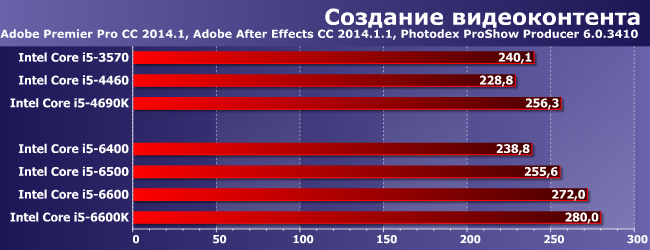
As you can see, even now, when processing video, it is far from always possible to derive such significant benefits from OpenCL as in the first diagram (however, work on new version testing methods showed that updating the software in this group also allows you to slightly change the situation, but it’s too early to talk about this in detail), so sometimes the video core can be neglected. But it is not the only advantage of Skylake over Haswell, so here, already with 4690K, the 6500 “butts” almost on an equal footing.

It is noteworthy that, despite the somewhat different "preferences" of the programs included in this group, the result is similar to that obtained in the previous one. And from the repeatability it follows that it is hardly something special :)

But not obligatory either - as we have already written more than once, Adobe regularly releases new versions of this program, but the approach to its optimization has not changed for at least five years. Accordingly, all that is needed here is one or two high-frequency cores and nothing more. From this point of view, the new processors are no better than the old ones, so this also applies to performance. We also note that this is one of the few cases where the performance of 6600 and 6600K differs noticeably. The reason is simple - with a uniform load, there is no difference whether the clock frequency of the cores used is received as a “phenomenon from above” or achieved through Turbo Boost, but when the load “jumps”, an economical processor with a long frequency range sometimes it just “does not have time” to increase the frequency. From the point of view of energy saving, this approach is useful - since it was possible to do some work quickly without even increasing the frequency and voltage of the supply, this is good. But the performance, as we see, is not the best effect.

That Audtion, despite regular (before) optimization, sometimes behaves very similar to Illustrator, we also noted more than once. In this case, we have an intermediate between “good” and “bad”: 6600 and 6600K are approximately equal here, but 4690K is still only behind them. No, in general, "convincing superiority" of the new family.
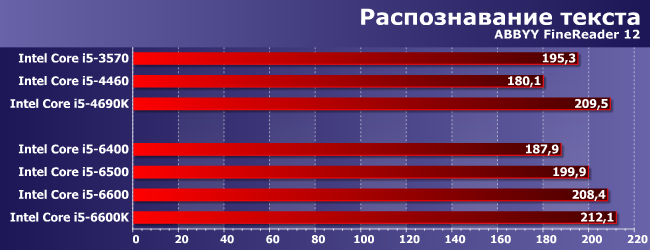
Text recognition, obviously, is the case when, even if you want, you can’t “optimize” anything. Unless multithreading can be utilized more fully, but this does not matter when comparing processors of the same class (they are all “four cores, four threads”), and the graphics core, if ever it will be put into the service of people, is clearly not now. Take instead of 4690K 4690S (which in terms of TDP is just much more similar to the new Core i5) could have come out better. But since Intel believes that it is possible to limit all processors (except for the K-family) to 65 W, then newcomers have to operate in uncomfortable conditions without any discount on the latter.

Although sometimes they really need it - in this case, it turns out something similar to parity already “at both ends of the range”, which, in our opinion, is even worse than when older models are not much faster than their predecessors.
 |
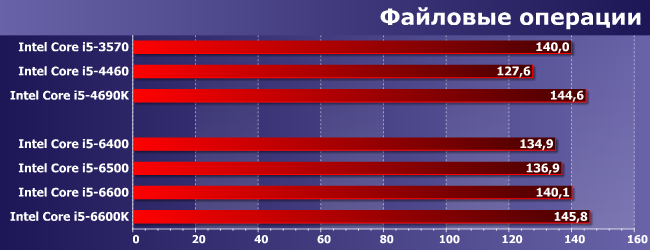 |
And in these cases, it is the same. Although in terms of functionality in terms of supporting various high-speed drives, the new platform is much better than its immediate predecessor, not to mention LGA1155, this does not always affect performance accordingly. With the same drive, but different processors it may be different. Actually, why we prefer not to refuse these tests - after all, this is what any user of a real computer encounters in practice, where the processor does not work in a spherical vacuum at all.
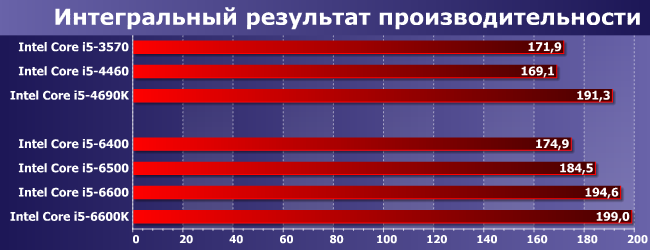
What do we end up with? Fundamentally, the performance of the Core i5 has not changed and has not changed for a long time - it's just that all models in the family start to work a little faster with each generation. Radically increase the performance can only be increased by increasing the clock speeds, but they have long been kept at the same level (more precisely, in the same range), increasing only in dual-core models or processors for laptops. However, the development of the 14 nm process technology made it possible to increase the frequencies of the quad-core Core i5 with a TDP of 65 W, but at the same time they became the main ones in the Intel assortment, and earlier completely different heat packs turned out to be “basic”. In fact, they exchanged one for the other.
Gaming Applications
For obvious reasons, for computer systems of this level, we restrict ourselves to the mode minimum quality, and not only in "full" resolution, but also with its reduction to 1366×768: Despite the obvious progress in the field of integrated graphics, it is not yet able to satisfy the gamer demanding picture quality. And we decided not to test the Core i5-3570 at all on a standard gaming set: it is obvious that those of its owners who use the integrated video core are not interested in games at all. Suffice it to recall that the Pentium G2130 was unable to cope with any game from our set, with the possible exception of WoT, and its GPU is exactly equal to the HDG 2500. And the best HDG 4000 in Ivy Bridge also lacked stars from the sky, so and you can no longer remember about it, not to mention the younger IGP models in processors for this platform platform. Here are some newer solutions. something can. Here we'll see what.

As you can see, they start somewhere where Haswell ends. The differences, however, are mostly only quantitative, but they are also within the line: 4460 and 4690K can be considered completely the same, but in the 6x00 line, the GPU clock frequencies differ already by 200 MHz with more EU, which, together with a different heat pack and different performance of the processor part already leads to a visible effect.
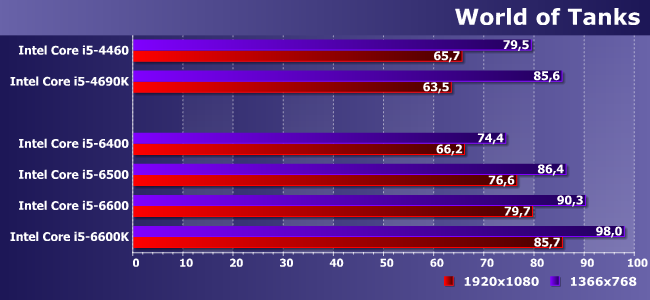
WoT is so undemanding to graphics that here, in practice, the resolution can not be reduced, but played in full, so this mode is important. In which the i5-6400 is already faster than any processors under LGA1150, and 6600K shows the same frame rate as 4690K in low resolution.
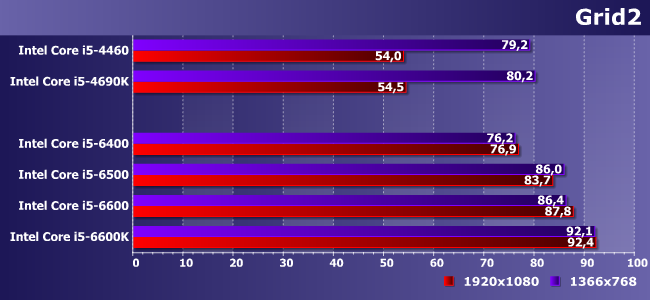
In Grid2, again, the main "breakthrough" in FHD. It is due not only to a change in quantitative characteristics, but also to internal changes in the graphics core (formally, this is one and a half generations, while only half of it has changed from Ivy Bridge to Haswell), but the main result is one and a half to two times, which will clearly allow you to refuse from the minimum quality settings and improve the picture.
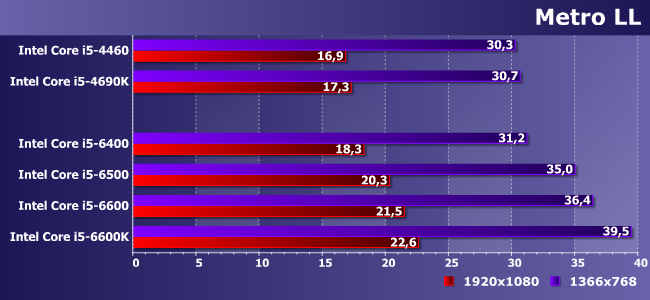
In principle, Core i5 for LGA1150 were already minimally suitable for this game (albeit only at low resolution), but against the background of LGA1151 this result is somehow lost: even the i5-6400 is at least a little, but faster, and older models are already unconditionally suitable.
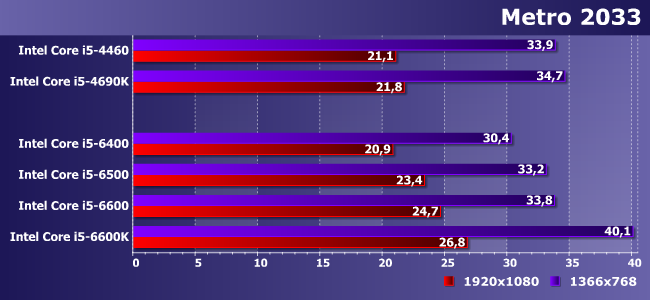
More old game series is more demanding on the performance of the processor part, which, in conditions of a limited heat pack, has a negative effect. However, with the exception of the i5-6400, we see results of the same level at low resolutions and better performance in FHD. It's a pity that it's still insufficient for the game, though... Although in practice it is possible to choose an intermediate resolution, for example, so that improvements in the graphical part are at least not useless.

We return to the "good" cases. Without qualitative changes (for HD it was enough before, in FHD it is still not enough), but with pleasant quantitative ones.

In FHD, the performance is still too low, but in HD resolution we are gradually approaching the border of "playability". At least we are getting closer - on the LGA1150 it was too far away. Unless, of course, we consider exclusively Haswell - i5-5675C, for example, is already enough to somehow play, but this is a special story.

Quad-core processors have previously handled this game at full resolution, but without any headroom. Now it has started showing up. What's funny, the frame rate in the case of older models is already almost the same as provided by AMD A8 processors. It is clear that they are cheaper, but the performance in general-purpose programs is also different. But such an age-old advantage of AMD as higher gaming performance begins to gradually dissolve, which does not always require processors with GT3e.
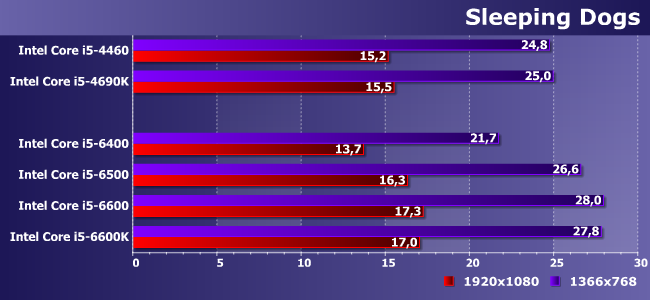 |
 |
However, far from everywhere everything turns out so well, but in general there is a performance increase. Of course, not the kind that could encourage some of the computer users on the old platform to upgrade - it's better to just buy a discrete video card, even an inexpensive one: it's still much more useful and less fuss. However, the buyer of a computer with a new processor for the same money will get a little more than he could a year ago.
Total
The state of affairs in the segment of processors for desktop computers has long been depressing for enthusiasts. To be honest, we are, to some extent, too: the easiest way to write about radical improvements - for example, the appearance of Core 2 in 2006 or Sandy Bridge in 2011. Then everything was simple and clear: new products are definitely better than their predecessors in all respects and in all areas of application. However, it is obvious that these "revolutions" were not so much born in the sector of desktop "personal computers" as they were a reflection of the processes taking place on the market. mobile computers(Core 2 was generally the heir to the notebook Core Duo). But then everyone else could benefit from new approaches and technologies, and now the changes are clearly not to improve the service for amateurs. big dust boxes. Rather, on the contrary: reducing cooling requirements is a clear step towards manufacturers compact systems, however, it no less clearly affects the potential performance. However, it is easy to see that the increase in the performance of processor cores has stopped a long time ago, the increase in their number is all the more so, and what really becomes more and more powerful (i.e. processor graphics), an amateur does not need to play on a large desktop computer at all.
In general, it can be stated that the new platform is the same as the old one, but better. A little more productive, a little more functional, but not fundamentally different. On the other hand, this is not required: until new needs appear in the mass segment (such as multimedia technologies or 3D games in the decade before last, for example), a significant increase in computing power is also not needed. In principle, everyone who wanted to buy desktop computer, it has already been done. And if it sometimes has to be changed (due to failure, for example), then the same one as it was is quite suitable. So far, it turns out that new computer will be at least a little, but better than the old one. But only a little. The times when everything could change on the market in three to five years remained only in oral traditions (however, if you look closely at history, they never existed).
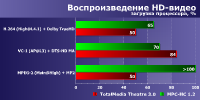
The Intel Core i5-4460 processor combines impeccable performance and high energy efficiency. It's perfect for assembly. workstation, and for organizing a gaming computer. But in order to unleash its full potential, it is necessary to complete such a computing system without fail with a high-performance one. graphics card. It is this semiconductor product that will be discussed further.
Processor Solution Niche
Modern semiconductor chips from Intel are divided as follows:
Entry-level processor solutions are Celeron and Pentium. These chips include only 2 compute modules, a low fixed clock speed, and a reduced amount of cache memory.
The middle segment of the market for central processors is occupied by Core i3 silicon crystals. Their technical specifications are almost identical to the previous two families of CPUs, but the presence of technology such as HT allows this computing product to process program code already in 4 threads. As a result, these processors are great for building mid-range gaming PCs and workstations of the same kind.
The premium segment is occupied by i5 and i7 solutions. Any representative of this model range it has 4 computing units without fail, supports dynamic clock frequency change technology and has an increased cache size. As a result, such PCs are the most versatile and allow you to solve any problems. It is to this niche that the considered CPU belongs - Core i5-4460.
Types of configuration of the CPU. What do they include?
In two options the semiconductor product in question is supplied. The more affordable one in the price lists is called Tray. The manufacturer included the following:
Processor in a plastic box.
Instructions, a branded sticker with the logo of the chip model and a warranty card - this is a complete list of paper documentation.
As you might guess, the above list lacks thermal paste and a cooler, which in this case will have to be purchased separately. The most appropriate purchase of a central processor in this configuration looks like when the assembly is put on the conveyor and sold as part of a large computer company. In this case, you can negotiate with the supplier company and buy a cooling system at a wholesale price. At the same time, the cost of the latter may be lower than that of a branded cooler from Intel. The second configuration option is called Vox. It, in addition to everything previously mentioned, also includes a regular cooler and branded thermal paste. It is this configuration option that is most optimal for assembly system block both in a small company and even at home.
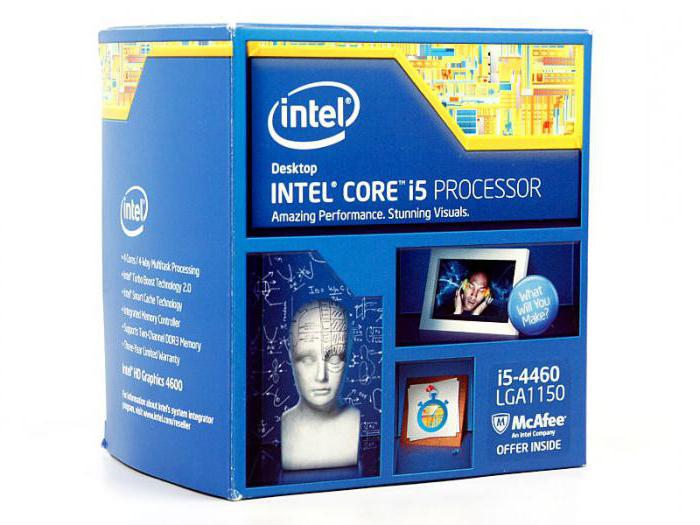
Frequencies
As noted earlier, the technology of dynamic clock frequency control is implemented in the considered central processor. The minimum frequency for the Core i5-4460 is 3.2 GHz. In this mode, this processor solution works when all 4 of its computing modules are involved at once. Also, the processor can lower the clock frequency to this value in the event that, for any reason, a significant increase in the temperature of the semiconductor crystal has occurred. The maximum frequency value is 3.4 GHz. Such an increase in this parameter occurs when some resource-intensive task is started.
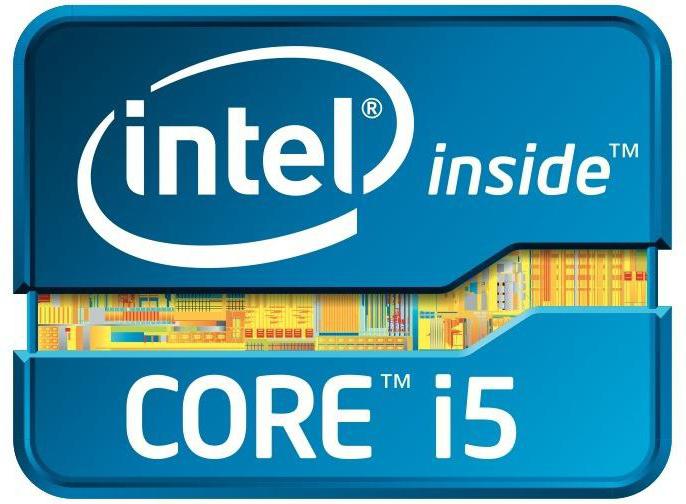
Cash
The Core i5-4460 boasts a powerful built-in integrated system of 3 cache levels. The characteristics of its first level indicate the presence of only 256 KB. These 256 KB are divided into 4 parts of 64 KB, which can only exchange data and program code with a certain computing core. The second level of fast memory has a capacity of 1 MB, and the third - 6 MB.
RAM
An integrated RAM controller is equipped with an Intel Core i5-4460. It aims to work in tandem with DDR3 modules. The recommended clock speeds for RAM sticks are 1333 MHz or 1600 MHz. You can also use faster RAM modules, but the use of the latter in such a computer configuration is not entirely justified for the reason that their frequency will be automatically reduced to the same 1600 MHz. The maximum possible amount of RAM in this case is 32 GB.
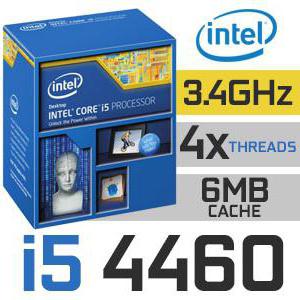
Architecture. Technology. energy efficiency
The 4th generation of chips, codenamed "Haswell", belongs to the Intel Core i5-4460. Its characteristics indicate the presence of four full-fledged physical code processing units. Support for proprietary NT technology from Intel, which allows you to process 2 threads at once on one real core program code, not tied. Therefore, the operating system or any other software will see in this case only only 4 cores. This chip is installed in the LGA1150 processor socket. The maximum temperature of the semiconductor solution is 72 ° C. Its thermal package corresponds to 84 watts. This CPU also includes a graphics adapter. Its model is HDGraphics 4600. Its clock frequency range is limited to 0.35-1.1 GHz, and the number of displays to which it can output simultaneously is 3.
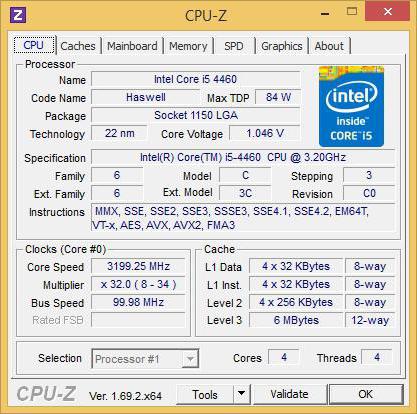
Price
The Core i5-4460 processor can be purchased for 10,000-11,000 rubles. Of course, there are also more affordable chips. But their combination of price and performance is not as attractive as that of the semiconductor solution under consideration. The same can be said about more expensive CPUs. Therefore, when organizing a high-performance gaming computer system one of the most optimal candidates at the moment is this quad-core chip. It is also perfect for implementing an entry-level server, workstation or even a graphics station (in the latter case, a powerful discrete graphics subsystem is required).
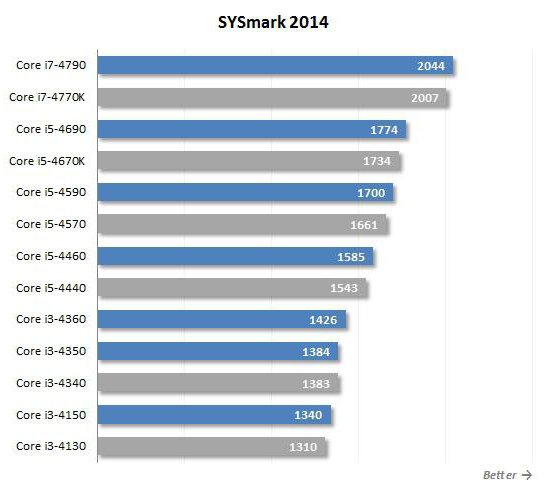
Tests. Performance. Comparison with analogues
The direct competitors of the Core i5-4460 today are the i5-4690 and i7-5775 processors from Intel. The AMD company, in turn, can oppose the hero of this review with the FX-8370 and A-7800. The test results in 1920X1080 mode and ultra settings are shown in the table below.
Processor test results
Test name | Unit | ||||||
Sisoft Sandra 12 | |||||||
The processor solution under consideration is significantly ahead of all its opponents from the "red" camp in almost all tests. Inside Intel's products, there is a strict hierarchy, and a more expensive chip necessarily has a higher performance. So in this case: the two i5-4460 competitors have higher clock speeds. The i7-5775 also boasts 8 code processing threads and an increased cache size. As a result, their performance is higher than that of the hero of this review.
![]()




